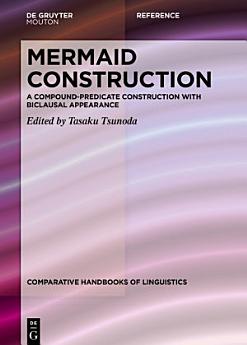Mermaid Construction: A Compound-Predicate Construction with Biclausal Appearance
Tasaku Tsunoda
agt 2020 · Comparative Handbooks of Linguistics [CHL] Livre 6 · Walter de Gruyter GmbH & Co KG
E-book
882
Pages
reportLes notes et avis ne sont pas vérifiés. En savoir plus
À propos de cet e-book
This volume provides detailed studies of the crosslinguistically unusual mermaid construction in seventeen languages of Asia, including Modern Standard Japanese, and one language of Africa. This construction appears to be absent in languages of Europe, Oceania and the Americas. The name - mermaid construction - alludes to its paradoxical make-up, where the structure closely resembling a verb-predicate clause ends with what may look like a noun-predicate clause. Superficially it looks biclausal; however, syntactically it is monoclausal. It has a compound predicate which contains an independent noun, a clitic or an affix derived from a noun, or a nominalizer. Its compound predicate has a modal, evidential, aspectual, temporal, stylistic or discourse-related meaning. The paradox is resolved from a diachronic perspective insofar as a biclausal structure is reanalyzed as a monoclausal one. This volume shows how a noun may be reanalyzed to become a constituent of a predicate. It constitutes an important contribution to research on grammaticalization and in particular, the grammaticalization of nouns and more generally, to the typology of syntactic reanalysis.
À propos de l'auteur
Tasaku Tsunoda, Prof. Em. National Institute for Japanese Language and Linguistics, Tokyo, Japan.
Donner une note à cet e-book
Dites-nous ce que vous en pensez.
Informations sur la lecture
Smartphones et tablettes
Installez l'application Google Play Livres pour Android et iPad ou iPhone. Elle se synchronise automatiquement avec votre compte et vous permet de lire des livres en ligne ou hors connexion, où que vous soyez.
Ordinateurs portables et de bureau
Vous pouvez écouter les livres audio achetés sur Google Play à l'aide du navigateur Web de votre ordinateur.
Liseuses et autres appareils
Pour lire sur des appareils e-Ink, comme les liseuses Kobo, vous devez télécharger un fichier et le transférer sur l'appareil en question. Suivez les instructions détaillées du Centre d'aide pour transférer les fichiers sur les liseuses compatibles.








